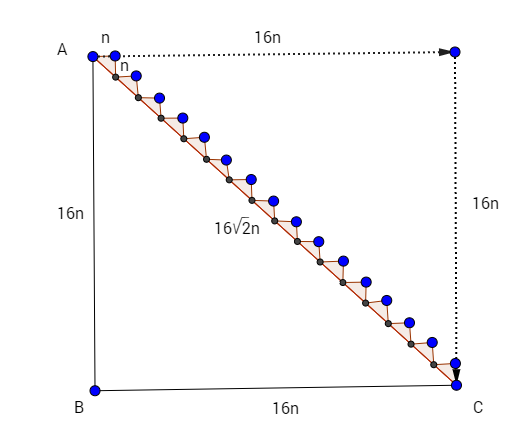There is an argument known as Weyl's tile argument which is not physics but philosophy, involves some really easy math and accessible to laymen like myself. Still, I'm tempted to put this here since it answers your question even though this probably doesn't belong on a physics forum.
In a discrete space, say a square/rectangular tiled space, (for convenience) we start by constructing two sides of a triangle, each of 1 unit length . To traverse the hypotenuse from either point, we have to move one unit of length to the right (or left) and one unit of length down (or up).

Say AC is traversed in 2 steps, A-D, D-C we have a length of 2 units along AC in the tiled space.
Suppose we keep increasing the number of steps taken from A to C and decreasing the size of unit length, path along AC would look like this :
Length along the zig zag path above AC is still larger than the length of hypotenuse by factor of √2, which was the same factor when we used a much larger unit of space and only 2 steps (n=2) to traverse along the hypotenuse!
This is essentially the Weyl's tile argument
the former result does not converge to the latter for arbitrary values of n, one can examine the percent difference between the two results: (n√2 - n)⁄n√2 = 1-1⁄√2. Since n cancels out, the two results never converge, even in the limit of large n.
This tells us that no matter how small a unit of length we take, not even an infinitesimal length, would even approximate the pythagorean theorem in a discrete space.
It happens to be true because of the simple observation that you have to be able to travel across in space in any direction, which is, in this example, 1/2 to the right & 1/2 to the down (45°) simultaneously for a unit , and not a unit towards right then a unit to the down, which is what happens if we discretise length. For the pythagorean theorem to work, a fixed length measured along one direction must not vary when measured along another direction. This is known as isotropy of space, which is a property of the continuum.
Discrete models with different structures other than rectangular can also be disproved using the same argument.
In a sense, this argument doesn't fall prey to unfalsifiable claims that there is discreteness, but beyond our abilities to experimentally observe. It doesn't matter how small the "grains" or "pixels" may be.
Take 3 sticks, two of them having a length of 1 metre and one of approx 1.414 metre, all of them measured along a common axis. Try to make a right triangle, if the hypotenuse falls well short of completing the triangle or after some rotation, extends beyond it, (heh) you're in a universe with discrete space.
About Time
Relativity itself only actually observes that there is “movement”, and “assumes” there is “time”.
If, I say, for instance “The bus arrives here at 9 o'clock,” I implicitly mean that the pointing of the small hand of my watch to 9 and the arrival of the bus are simultaneous events
This seems perfectly acceptable, unless you realise that we are comparing the co-ordinates( location) of one thing to a thing called “time”.
But in fact, the co-ordinates of one thing (a bus) are only compared to the coordinates of another thing ( the location of a rotating pointer, or the pulse in the circuit, in case of a digital clock ).
The point being, coordinates of space are used to measure time, so one could say they are really the same thing. If space is continuous, so is time.



